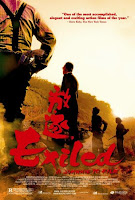 Julien Donkey-Boy (Harmony Korine, 1999)Rating:
Julien Donkey-Boy (Harmony Korine, 1999)Rating: 9.3
Harmony Korine based this film and the character of Julien on his schizophrenic uncle. His intent was to avoid the simplicity and sentimentality that coincide with the portrayal of most mentally ill characters in mainstream cinema. Korine opts to delve into the disturbing world and fragmented imagination of an ill teenager and his insane family using the medium to help communicate a haunting depiction of reality that some people have to face. The film employs the techniques of the Dogme 95 manifesto including digital video format, natural lighting, hand-held camera work, realistic characters and settings, etc.; but Korine sets himself apart from the other Dogme films, that I've seen at least, by adopting his own aesthetics, using in camera adjustments such as shutter speed and aperture tinkering as well as high gain lending a very grainy look to the film. To some the look might seem unappealing, but I found it to be an excellent choice, especially given the tone and subject of the film. The cinematography is impressive throughout as the film presents several interesting compositions, my favorite of which being a dutch shot of the distant silhouette of Werner Herzog (Julian's father) wearing a gas mask and dancing to opera music framed between the candles of a beautiful chandelier in the foreground. Korine also uses editing to capture Julien's schizophrenic mindset and presents much of the narrative through a series of vignettes, sometimes employing frantic jump cuts and other times using a montage of still images as the sound continues in real time.
The film presents the characters as being out of touch with reality, and almost inside their own bubble, that we as viewers are not permitted to leave for the duration. However their is still a very humanistic quality to the presentation. In one touching scene Julien's pregnant sister played by Chloë Sevigny talks with him on the phone, pretending to be his deceased mother and comforting him; telling him the voices he hears are friendly and that she is watching him. Werner Herzog's antics are the most ridiculous and actually quite hilarious as he insults his children by calling them cowards, dilettantes, and sluts, chugs cough syrup from a slipper, offers his son $10 to wear his mother's dress and dance, and so on. Julien's brother Chris is another interesting character. Although he is seemingly the most "normal", his unsettling obsession with becoming a wrestler and rigorous training regiment appears just as insane as any of the other character's actions, especially when he begins wrestling a plastic trashcan. Another hilarious scene unfolds when Julien and Chris indulge in a wrestling match as the rest of the family watches and cheers them on.
Throughout the film a religious motif is prevalent as the family uses prayer and church hymns in different ways. In one scene the family appears to be the only Caucasians at an otherwise all black congregation. I'm not exactly sure if Korine means to deface religion or just acknowledge it's utility as a crutch by juxtaposing such iconography with the lower class, the less fortunate, and even insane and freak-like characters. My only minor complaint about the film is that it too often introduces random odd characters such as a black albino man, an armless man who does card tricks and plays drums, and a man who performs cigarette tricks. During these moments I felt the film begins to resemble a freak show of sorts, rather than offering something of value to the piece as a whole, but when it sticks to the examination of the family, the film really works.






























